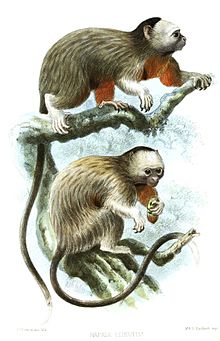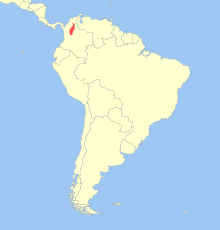White-footed tamarin
| White-footed tamarin | |
|---|---|
 |
|
| Scientific classification | |
| Kingdom: | Animalia |
| Phylum: | Chordata |
| Class: | Mammalia |
| Order: | Primates |
| Family: | Callitrichidae |
| Genus: | Saguinus |
| Species: | S. leucopus |
| Binomial name | |
|
Saguinus leucopus (Günther, 1877) |
|
 |
|
| Distribution range of Saguinus leucopus in South America | |
The white-footed tamarin (Saguinus leucopus) is a tamarin species endemic to Colombia. It is a silvery brown colour with pale streaks and russet underparts, and is very similar in appearance to the cotton-top tamarin, from which it is separated by the Atrato River. It is thought that the two species diverged during the , at a time when a sea occupied the area between their present ranges. This tamarin is an arboreal species, living in small family groups in the canopy. Females give birth to one to three young after a gestation period of about 140 days. This species has a relatively small range and is under threat from destruction and fragmentation of the forest in which it lives and the International Union for Conservation of Nature has assessed its conservation status as "endangered".
Some authorities, such as Thorington (1976), posit that S. leucopus is very closely related to the cotton-top tamarin, Saguinus oedipus. Other analyses made by Hernandez-Camacho & Cooper (1976), and later Mittermeier and Coimbra-Filho in 1981, and finally Grooves (2001) This view is supported by Hanihara & Natoria’s multivariate analysis of toothcomb dental morphology (1987) and by Skinner’s work in 1991, which found high similarity between S. oedipus and S. leucopus in 16 out of 17 morphological traits considered. This is further supported by the transition from child to adult, during which the fur coloration changes take place and are similar between the two species.Philip Hershkovitz proposed that the divergence of the two species occurred in the at the height of the Atrato River, where it intersected the Cauca-Magdalena. At this time, the area was covered by a sea, which created a geographic barrier which caused this ancestral species to diverge from S. oedipus through the process of allopatric speciation. Today, the two species are principally separated by the Atrato river.
...
Wikipedia

